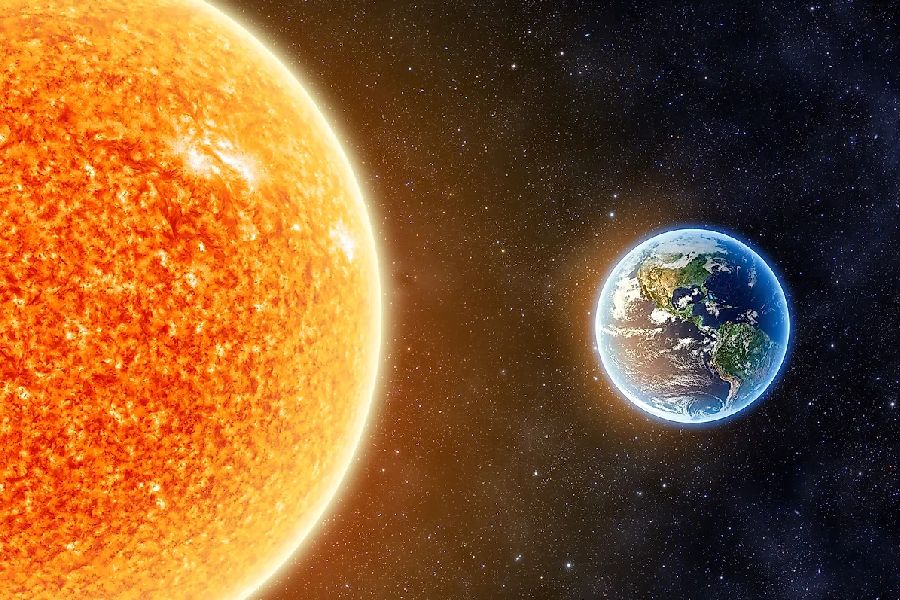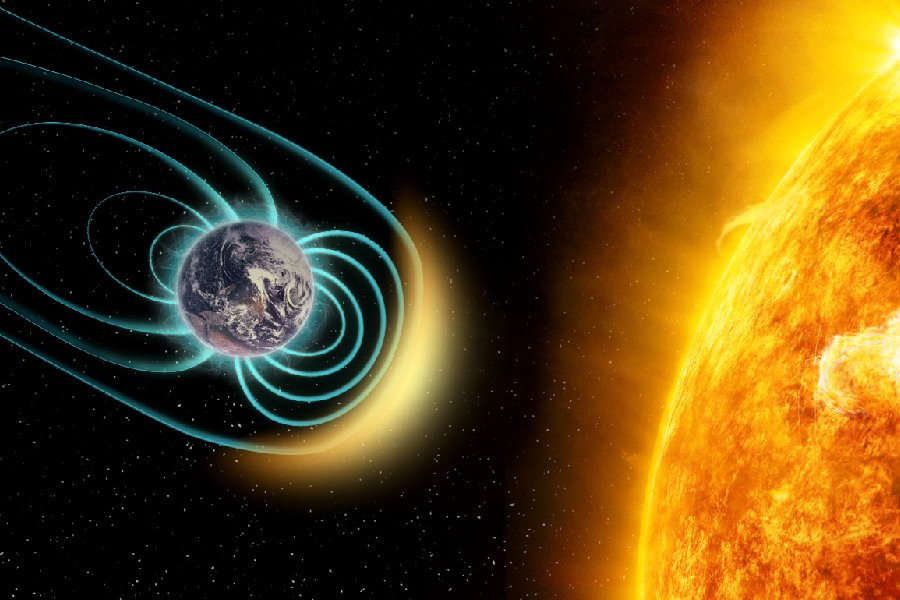Have you wondered what protects us from solar winds blasting from the Sun? Without this protective shield, the fierce winds could erode our precious atmosphere over time. So, what protects Earth from solar winds?
In this article, we’ll unravel Earth’s defenses against radiation and storms from our powerful star. We will also cover how the atmosphere and ozone layer as additional barriers, absorbing radiation that makes it through.
While solar storms can occasionally disrupt satellite signals and power grids, overall, Earth has effective defenses in place filtering out the constant stream of solar energy and radiation.
Join us to discover some key players involved in protecting Earth from solar winds. We will examine the planetary shields that safeguard Earth from intense solar energy and radiation blasting from the Sun – our closest star, which, while vital for life, also poses hazards from its incredible power.

What Protects Earth From Solar Winds?
So, what protects Earth from solar winds? Earth has a few protective shields against solar storms and winds from the Sun. The magnetosphere acts as a magnetic bubble surrounding Earth, deflecting charged particles streaming in the solar wind.
As some radiation penetrates this outer defense, our atmosphere provides secondary absorption of incoming space energy. Additionally, the ozone layer helps filter damaging ultraviolet radiation, while Earth’s molten core generates the intrinsic planetary magnetic field via dynamo processes. This further shields against solar particle effects.
So the magnetosphere, atmosphere, ozone layer, and inlying magnetic field all play vital roles together in what protects Earth from intense solar winds. These barriers maintain livable surface conditions despite outbursts from our closest star.
Significance of Understanding Solar Winds
The Sun constantly emits a stream of charged particles known as solar wind, flowing past Earth and other planets. Learning properties helps predict space weather impacts to take precautions.
Monitoring effects even during low solar activity aims to enable accurate forecasting to mitigate interference risks posed to satellites, communication systems, and power grids.
Solar storms sometimes disrupt satellite signals, power grids, and GPS networks. But even when storms are not occurring, solar wind is always present to some degree and can cause interference. Our goal is to accurately track solar wind conditions and forecast space weather disturbances to mitigate their impacts.
How Solar Winds Affect Earth
Solar wind quietly accumulates subtle effects, changing atmospheric thickness over the years. Magnets waver under this persistent weather as compass needles nudge. Power grids risk overload if electrical shiftings are short during extreme solar storms. But increased drag also incrementally pulls satellites from proper orbits.
Energized particles from the solar wind penetrate Earth’s atmosphere to glow as auroras. Ionization from these particles molds geomagnetic stability over the approximately 11-year solar cycle as incoming energetic inputs meet oxygen and nitrogen in the atmosphere. Forecasts help utilities avert blackouts by anticipating extra-induced currents.
Research illumination of solar wind impacts protects astronauts from radiation and helps operators shield equipment when particles accelerate to extreme velocities.
Interaction with the magnetosphere
As the solar wind strikes Earth’s magnetosphere, the particles interact with the magnetic bubble. Some change direction while others become trapped in field lines or penetrate magnetosphere cracks that open and close, morphing its shape.
Powerful solar wind gusts first squeeze, then shake the swaying magnetosphere. Layers of electrical currents ripple as particles move around the magnetic barrier edges. Openings in the shield let particles go deeper, hitting atoms in the atmosphere to create glowing auroras.
Though complex, order emerges by connecting “space weather” to solar eruptions. But storms can disrupt the magnetodance, interfering with communications as compasses spin awry until equilibrium returns.
Effects on the atmosphere
Energetic particles penetrate to increase ionization as they meet nitrogen and oxygen. Shaped over the Sun’s 11-year cycle, storms accelerate ions to spawn auroras and radio disturbance due to atmospheric chemistry changes.
Detecting effects even under quiet conditions helps quantify the influence on density that elevates satellite drag over time. Charged solar wind alters ionospheric layers that bounce communications worldwide, refracting signals that otherwise pass through thinner air.
Studying historical tempests and today’s sparks alike, we link the Sun to the spectacle of sky but also to channel performance when scintillation competes amid the noise. Tracking shifts in radio propagation fills knowledge gaps about solar weather cascading down to Earth.
Impact on communications and technology
When extreme space weather events occur, transformers that aren’t designed for excess voltage can get overloaded by induced ground currents. And it’s not just the immediate effects – consistent shifts in the electrical baseline can cause problems to accumulate over time. Operators are also noticing that intensified corrosion in pipelines can be attributed to solar activity.
Aviation and naval operations, which heavily rely on communication systems, can experience radio blackouts during solar events. This is especially true as satellite connectivity advances have made them more susceptible.
Now, system architects are taking a closer look at resilience because solar flares have the potential to cause widespread outages, which can impact global commerce. It’s important to strengthen our infrastructure to address this modern vulnerability and prepare for the next storm.

How Is the Earth Protected From Solar Winds?
Earth has shields against charged particles like the magnetosphere diverting influxes. The atmosphere also absorbs excess energetic inputs. So redundancies exist, safeguarding systems.
Rapid responses counter solar storm variability threats. But the steady state wind also incrementally molds climate signals within multi-layered protective spheres tailored to Earth’s needs by checks and balances between domains.
Coupled shields like the magnetosphere and atmosphere dynamically respond together to external changes from the Sun. Ionization chemistry alters, climates fluctuate as particles propagate, yielding auroras visible in the skies.
While storms rouse quick reactions, the prolonged solar winds also subtly ebb and flow, gradually influencing climate embodiments within a woven fabric of natural defenses around Earth arising through interconnected balancing mechanisms.
Parker Solar Probe
Launched in 2018, Parker Solar Probe carries instruments to sample the Sun’s atmosphere itself. Early data unveils mysteries around energetic particle origins, unlike prior models, promising to transform understanding of solar wind impacts.
As the daring craft ventures nearer each orbit, revelations continue to emerge from this boundary-pushing mission. Increasing proximity lets Parker Solar Probe uncover the origins of strange phenomena observed from afar but now explicated on site.
Goddard space flight center
NASA Goddard spearheads investigations seeking expanded comprehension ranging from within the Sun out to the farthest interstellar frontiers, enabled by specialized technological insight paired with mission-driven resolve.
By overseeing key instruments like aboard Parker Solar Probe plus managing deep space communications arrays, Goddard propels discoveries about solar wind generation, strengthening reliable predictions of Sun-Earth interactions for the current epoch.
Additionally, Goddard stewards upcoming satellites slated to fly through the Sun’s corona itself carrying pioneering analyzers and samplers, sheltering fragile detectors recording previously inaccessible measurements from the rarefied hot plasma.
These audacious plans typify the Center’s far-sightedness, expanding perception itself of local neighborhood space weather and dynamics – the better to safeguard technologies we increasingly depend upon.
Magnetic field lines and polar regions
Funneling along Earth’s magnetic field lines, charged particles focus into the polar regions, coordinating intricate magnetosphere bubble dynamics. Colliding with glasses there, they release auroral hues – optical phenomena connecting space to place.
By monitoring heightening geomagnetic polar responses, researchers parse solar wind contributions versus magnetospheric effects, which together enable the relative alignment of planets amid an ever-changing solar fire.
During the polar nights, we witness the mesmerizing phenomenon of shifting displays of radiant light. This breathtaking spectacle occurs as Earth’s dipole tilt directs solar particles toward the upper atmospheric gasses, resulting in dynamic interactions.
Electric fields and electric currents
Electric fields direct charged particle flows, including within solar wind fluxes themselves, propagating self-consistent fluctuations that transmit across expanding magnetic spheres of influence.
Careful monitoring allows tracking electrical state environments as interconnected facets that underlie power transmission, community resilience, and orbital asset longevity.
Quantifying currents and field gradients brings acuity to electrons unleashed by sunlight’s journey. Differentials drive charged flows, altering transmission and technology function during periods of geomagnetic unrest induced by shifting solar particle influx.
Conclusion
We hope this article has revealed multifaceted insights on what protects Earth from solar winds. By exploring our planet’s clever magnetic and atmospheric shields against particle influxes and radiation, you now better grasp natural safeguarding dynamics.
Tracking the swelling and ebbing effects of solar weather on technology and infrastructure has also underscored the importance of prediction to help brace against what would otherwise impact Earth. As daring missions venture closer toward the winds’ origins, new discoveries promise to advance forecasting capabilities further.
By unraveling the fundamental processes that shield our planet, we progress toward more skillful management of both hazards and awe-inspiring phenomena that emerge from what protects Earth from our Sun’s fiery expulsions.
Ongoing solar science is illuminating this intricate relationship between particles unleashed outward and their variable consequences cascading down to us across time and space.
